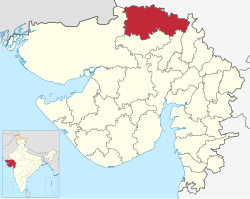Banaskantha district | |
|---|---|
 Location of Banaskantha district in Gujarat | |
| Coordinates: 24°10′23″N72°25′53″E / 24.17306°N 72.43139°E | |
| Country | |
| State | Gujarat |
| Region | North Gujarat |
| Established | 01 May 1960 |
| Named after | Banas River |
| Headquarters | Palanpur |
| Area | |
• Total | 6,176 km2 (2,385 sq mi) |
| Population (2011) [1] | |
• Total | 2,520,507 |
| • Rank | 111 of 640 in India 5 of 26 in Gujarat |
| • Density | 408.1/km2 (1,057/sq mi) |
| Languages | |
| • Official | Gujarati, Hindi |
| Time zone | UTC+5:30 (IST) |
| Vehicle registration | GJ 08 |
| Website | banaskantha |
Banaskantha district is one of the thirty-four districts of the Gujarat state of India. The administrative headquarters and largest city is Palanpur. The district is in northeastern Gujarat where the West Banas River runs through the valley between Mount Abu and Aravalli Range, flowing to the plains of Gujarat in this region. [2] The district is famous for the Ambaji temple which draws many tourists. [3] It has an area of 12,703 km2 and was the second largest district in the state until January 2025, when Vav-Tharad district was carved out of the western part of the district and remaining area of 6,176 km2 remains the same. [4]






